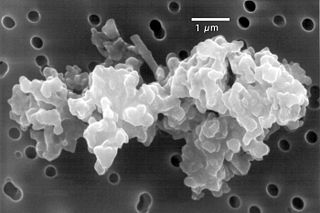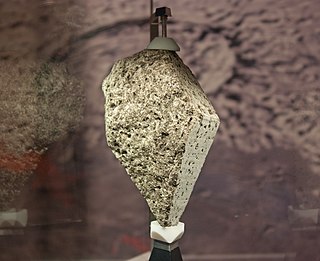Related Research Articles

Lonsdaleite, also called hexagonal diamond in reference to the crystal structure, is an allotrope of carbon with a hexagonal lattice, as opposed to the cubical lattice of conventional diamond. It is found in nature in meteorite debris; when meteors containing graphite strike the Earth, the immense heat and stress of the impact transforms the graphite into diamond, but retains graphite's hexagonal crystal lattice. Lonsdaleite was first identified in 1967 from the Canyon Diablo meteorite, where it occurs as microscopic crystals associated with ordinary diamond.

A meteorite is a solid piece of debris from an object, such as a comet, asteroid, or meteoroid, that originates in outer space and survives its passage through the atmosphere to reach the surface of a planet or moon. When the original object enters the atmosphere, various factors such as friction, pressure, and chemical interactions with the atmospheric gases cause it to heat up and radiate energy. It then becomes a meteor and forms a fireball, also known as a shooting star; astronomers call the brightest examples "bolides". Once it settles on the larger body's surface, the meteor becomes a meteorite. Meteorites vary greatly in size. For geologists, a bolide is a meteorite large enough to create an impact crater.

A Martian meteorite is a rock that formed on Mars, was ejected from the planet by an impact event, and traversed interplanetary space before landing on Earth as a meteorite. As of September 2020, 277 meteorites had been classified as Martian, less than half a percent of the 72,000 meteorites that have been classified. The largest complete, uncut Martian meteorite, Taoudenni 002, was recovered in Mali in early 2021. It weighs 14.5 kilograms and is on display at the Maine Mineral & Gem Museum.

ANSMET is a program funded by the Office of Polar Programs of the National Science Foundation that looks for meteorites in the Transantarctic Mountains. This geographical area serves as a collection point for meteorites that have originally fallen on the extensive high-altitude ice fields throughout Antarctica. Such meteorites are quickly covered by subsequent snowfall and begin a centuries-long journey traveling "downhill" across the Antarctic continent while embedded in a vast sheet of flowing ice. Portions of such flowing ice can be halted by natural barriers such as the Transantarctic Mountains. Subsequent wind erosion of the motionless ice brings trapped meteorites back to the surface once more where they may be collected. This process concentrates meteorites in a few specific areas to much higher concentrations than they are normally found everywhere else. The contrast of the dark meteorites against the white snow, and lack of terrestrial rocks on the ice, makes such meteorites relatively easy to find. However, the vast majority of such ice-embedded meteorites eventually slide undiscovered into the ocean.

Cosmic dust – also called extraterrestrial dust, space dust, or star dust – is dust that occurs in outer space or has fallen onto Earth. Most cosmic dust particles measure between a few molecules and 0.1 mm (100 μm), such as micrometeoroids. Larger particles are called meteoroids. Cosmic dust can be further distinguished by its astronomical location: intergalactic dust, interstellar dust, interplanetary dust, and circumplanetary dust. There are several methods to obtain space dust measurement.

Moon rock or lunar rock is rock originating from Earth's Moon. This includes lunar material collected during the course of human exploration of the Moon, and rock that has been ejected naturally from the Moon's surface and landed on Earth as meteorites.

Nakhla is a Martian meteorite which fell in Egypt in 1911. It was the first meteorite reported from Egypt, the first one to suggest signs of aqueous processes on Mars, and the prototype for Nakhlite type of meteorites.
El Ali is a District in the central Hiran region of Somalia. El Ali has a population of around 120,000 inhabitants. The broader El Ali District has a total population of 543,345 residents. El Ali means. 99% of El-Ali's residents belong to the Galje'el Subclan of Dirisame.
Edward Ching-Te Chao was one of the founders of the field of impact metamorphism, the study of the effects of meteorite impacts on the Earth's crust.

2008 TC3 (Catalina Sky Survey temporary designation 8TA9D69) was an 80-tonne (80-long-ton; 90-short-ton), 4.1-meter (13 ft) diameter asteroid that entered Earth's atmosphere on October 7, 2008. It exploded at an estimated 37 kilometers (23 mi) above the Nubian Desert in Sudan. Some 600 meteorites, weighing a total of 10.5 kilograms (23.1 lb), were recovered; many of these belonged to a rare type known as ureilites, which contain, among other minerals, nanodiamonds.
Shock metamorphism or impact metamorphism describes the effects of shock-wave related deformation and heating during impact events.

Khatyrkite is a rare mineral which is mostly composed of copper and aluminium, but may contain up to about 15% of zinc or iron. Its chemical structure is described by an approximate formula (Cu,Zn)Al2 or (Cu,Fe)Al2. It was discovered in 1985 in a placer in association with another rare mineral cupalite. These two minerals have only been found at 62°39′11″N174°30′02″E in the area of the Iomrautvaam, a tributary of the Khatyrka river, in the Koryak Mountains, in Anadyrsky District, Chukotka, Russia. Analysis of one of the samples containing khatyrkite showed that the small rock was from a meteorite. A geological expedition has identified the exact place of the original discovery and found more specimens of the Khatyrka meteorite. The mineral's name derives from the Khatyrka zone where it was discovered. Its type specimen is preserved in the Mining Museum in Saint Petersburg, and parts of it can be found in other museums, such as Museo di Storia Naturale di Firenze.

Whitecourt crater is a meteorite impact crater in central Alberta, Canada, located approximately 10 km (6.2 mi) southeast of the Town of Whitecourt within Woodlands County. It is remarkable for being unusually well-preserved for a crater of small size and relatively young age.

The Tissint meteorite is a Martian meteorite that fell in Tata Province in the Guelmim-Es Semara region of Morocco on July 18, 2011. Tissint is the fifth Martian meteorite that people have witnessed falling to Earth, and the first since 1962. Pieces of the meteorite are on display at several museums, including the Museum of Natural History of Vienna and the Natural History Museum in London.

Northwest Africa 7034 is a Martian meteorite believed to be the second oldest yet discovered. It is estimated to be two billion years old and contains the most water of any Martian meteorite found on Earth. Although it is from Mars it does not fit into any of the three SNC meteorite categories, and forms a new Martian meteorite group named "Martian ". Nicknamed "Black Beauty", it was purchased in Morocco and a slice of it was donated to the University of New Mexico by its American owner. The image of the original NWA 7034 was photographed in 2012 by Carl Agee, University of New Mexico.

Lindy Elkins-Tanton is an American planetary scientist and professor whose research concerns terrestrial planetary evolution. She is the Principal Investigator of NASA's Psyche mission to explore the metallic asteroid 16 Psyche, Arizona State University Vice President of the Interplanetary Initiative, and co-founder of Beagle Learning, a tech company training and measuring collaborative problem-solving and critical thinking.
Although diamonds on Earth are rare, extraterrestrial diamonds are very common. Diamonds small enough that they contain only about 2000 carbon atoms are abundant in meteorites and some of them formed in stars before the Solar System existed. High pressure experiments suggest large amounts of diamonds are formed from methane on the ice giant planets Uranus and Neptune, while some planets in other planetary systems may be almost pure diamond. Diamonds are also found in stars and may have been the first mineral ever to have formed.

Alais or Allais is the first carbonaceous chondrite meteorite identified. It fell near Alès in 1806 in multiple fragments which together weighed 6 kg, although only 0.26 kg (9.2 oz) remains. The meteorite contains a number of elements in similar proportions to the Solar System in its primordial state. It also contains organic compounds and water. It has proved to be one of the most important meteorites discovered in France.
Elkinstantonite is a mineral with formula Fe4(PO4)2O that was first generated in a laboratory in the 1980s and first identified from natural origins in 2022, when the official mineral designation was also given. It is monoclinic, with space group P21/c (space group 14).
References
- ↑ Chris Herd (Nov 21, 2022). "The El Ali Meteorite: Ancient History and New Minerals"., talk given at the Space Exploration Symposium 2022, University of Alberta.
- 1 2 "Somalia meteorite: Joy as scientists find two new minerals". BBC News. 2022-11-29. Retrieved 2022-11-29.
- 1 2 "In meteorite, Alberta researchers discover 2 minerals never before seen on Earth | Globalnews.ca". Global News. Retrieved 2022-11-29.
- ↑ "U of A scientists help identify two new minerals found in 'curious' meteorite". edmontonjournal. Retrieved 2022-11-30.
- ↑ "Researchers discover two new minerals on meteorite grounded in Somalia". the Guardian. 2022-11-29. Retrieved 2022-11-29.
- ↑ MacPherson, Adrianna (2022-11-28). "New minerals discovered in massive meteorite may reveal clues to asteroid formation" (Press release). Alberta, Canada: University of Alberta. Retrieved 2022-11-30.